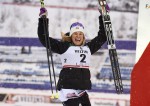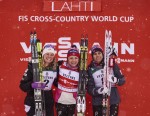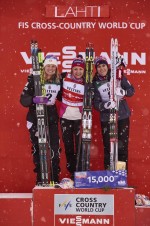LAHTI, Finland – An army of vuvuzelas echoed from the stadium’s stands and snow blew hard through the Lahti stadium on Saturday. The atmosphere was thrilling and the athletes no doubt felt it.
The “pre-World Championships” — a year out from 2017 World Championships — 1.6-kilometer freestyle sprints opened this weekend’s Lahti World Cup. There, Jessie Diggins, a Minnesota native and U.S. Ski Team member, reached the final for the first time in a year and finished second for her career-best sprint result.
Diggins entered the day with significant momentum following consecutive top-five finishes in Falun, Sweden, last weekend.
She was the second-fastest qualifier in the morning, just 1.68 seconds back from Norway’s Ingvild Flugstad Østberg, who posted the fastest time in 3:30.85. Diggins then opted for the second quarterfinal in the heat selection process, along with World Cup Sprint leader Maiken Caspersen Falla of Norway and Finland’s local favorite, Krista Parmakoski.
After comfortably advancing from her quarterfinal in second place, behind Falla, Diggins landed in the first semifinal with the likes of Østberg, Falla and Sweden’s Hanna Falk. Diggins skied most all of her semifinal in fourth place behind these three women until the final bend before the finishing straight.
Going into this section, entering the stadium, there is a long decent where a bulletproof tuck and drafting can create an important passing opportunity right before the finish. Here, Diggins rocketed out from drafting behind Falk and glided into the inside lane for the final bend. After passing Falk, Diggins raced to third in the heat, behind Falla and Østberg. While this wasn’t quite good enough to ensure her automatic bid for the final, Diggins’ time was fast enough to give her one of two lucky loser spots to move on.
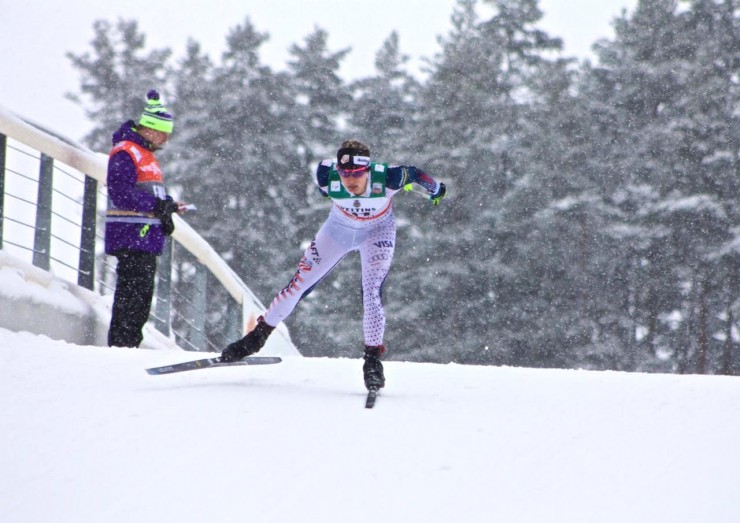
The women’s final consisted of Diggins, Falk and four Norwegians: Østberg, Falla, Astrid Uhrenholdt Jacobsen, and Heidi Weng.
The snow seemed to only pick up as the day went on, adding an exciting, yet also challenging strategic element to the race.
“The conditions made passing very difficult as the day went on because snow started to accumulate on the edges of the trail,” U.S. women’s coach Matt Whitcomb said in an in-person interview afterward. “So one of the strategies was to stay in control, at least in the middle of the pack, if not farther forward than that. Because [the fresh snow] placed those in the fourth, fifth and sixth positions at a pretty serious disadvantage in that final round, and even some of the semifinals.”
Out of the start, Diggins was unable to get to the front, but quickly climbed up through the pack into fourth position, behind Falla, Østberg, and Weng. Going into the second and final big climb, she held her position in fourth, all the way up to the top and the turnaround.
Then came that same long downhill, which Diggins had made her move at the bottom of during her semifinal. There was a small gap between Diggins and the three Norwegians as they entered the stadium, tucked in a line. Vuvuzelas blared at an all-time high and everyone waited with anticipation for the final moves and hectic finishing sprint.
Again, going into the final bend, Diggins slingshot out from the Norwegian slipstream and began her pass on the inside. She took the nearest lane and put the hammer down in the final sprint before lunging and claiming second in a photo finish with Weng.
“[Diggins] had gas at the end, so she hit the pedal,” Whitcomb recalled. “She was awarded with some extra speed and that made the difference today.”
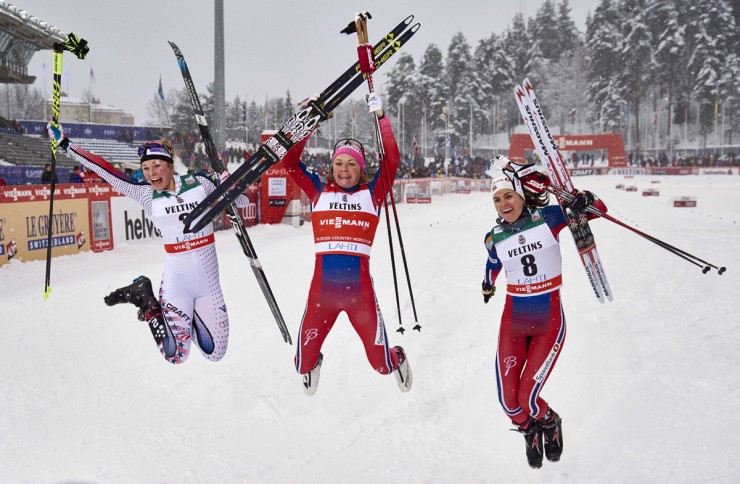
“In those finishing lanes, I was like, ‘I cannot believe this is happening! I can’t believe it!’ And I just gave it my best lunge I could,” Diggins said after the race. “I just am so happy – it was one of those things that was just incredibly fun and it was a great day out here with the team.”
The Sprint World Cup leader, Falla led most of the sprint as she usually does, and then held on for the outright win in 3:33.81. Diggins finished 0.25 seconds back in second place, beating Weng in a photo finish by six-hundredths of a second. Weng took third (+0.31), Østberg missed the podium in fourth (+0.41), Jacobsen was fifth (+2.27), and Sweden’s Hanna Falk finished sixth (+18.4).
For Falla, it was her fifth-straight sprint victory, and her sixth sprint win of the season. Asked how she does it, she responded: “I always try to stay in front of the heat,” she said during the post-race press conference. “And if I don’t get the first position, I really want the second one [because] I know it’s a big risk to stay behind in the sprint finals. You can always be in an accident, and people can get tired and make some space to the one racing in front. So I just try to stay in front and have some speed left before the last climb or the last meters.”
Weng earned her first win earlier this winter at the Tour de Ski, but Saturday added to her multitude of other podiums.
“ I tried to win, but Maiken and Jessie were faster,” she said. “In the last corner I was going too much on the right. [That made] it hard to fight for the victory.”
Slingshot Tactics and a Longer Course
Two key aspects of the race played out well for Diggins on Saturday: the inherently lengthier nature of the course and her draft into slingshot strategy.
“That was super exciting,” Diggins said about her final slingshot move. “I think I must have had the fastest skis in the world. I was counting on that slingshot to work for me and it did!”
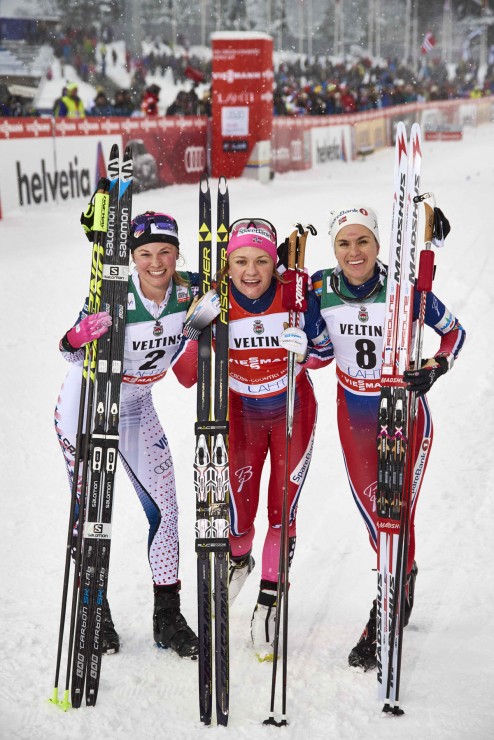
Norwegian winner Maiken Caspersen Falla (c), and Norway’s Heidi Weng (r) in third. (Photo: Fischer/NordicFocus)
This proved to be truly essential in both Diggins’ semifinal and final. In both races, she hovered around fourth place for the majority of the race until the final downhill and corner.
“You saw [Diggins] try a few different tactics [throughout the heats],” Whitcomb noted. “With the Norwegian girls leading most of the heats and Jessie working from the front-middle of the pack, she was able to try a couple different drafting strategies. And I thought by that final round, she timed the slingshot perfectly, so that it didn’t come down to just who was sprinting fastest, but who was coming in with just a fraction of a mile per hour of more speed.”
Another factor helping Diggins was that the longer-than-usual sprint course. At 1.6 kilometers, the Lahti sprint course is at the maximum allowed length. Also an accomplished distance racer, the course’s demand for some endurance played into Diggins’ strengths.
“If you can ski top ten in distance, a long sprint course is going to be your game,” Whitcomb said.
“It was a brutally hard course, it was a long course, [and] it was a hilly course” Diggins explained.
Her teammate, Sadie Bjornsen reflected on the course similarly after her second semifinal, in which she finished fifth (behind Weng, Jacobsen, Norway’s Therese Johaug, and Sweden’s Stina Nilsson, respectively) for 10th overall on the day.
“This is a fitness course, it is really, really long and it is hard,” Bjornsen said. “I think at the end of the day it is going to be those distance skiers that are going to [benefit]. You can see, [Diggins] is in there and she is probably going to win today because she is a distance skier and this takes some extra strength.”
Bjornsen proved to be just a few tenths of a second off with that prediction. Diggins’ distance experience and abilities prevailed on the Lahti course and she highlighted the U.S. day with second place.
Bjornsen 10th; Four U.S. Women Qualify
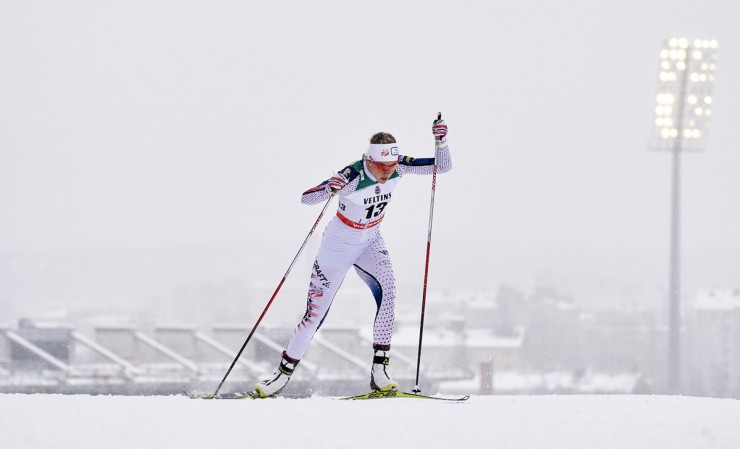
As a whole, the U.S. women’s team continued on its path of increasing momentum. Along with Diggins and Bjornsen, who qualified in second and 12th, respectively, Sophie Caldwell qualified sixth and finished in 13th, after placing third in the first quarterfinal and narrowly missing advancing as a lucky loser. Ida Sargent qualified 27th and finished in 24th after placing fifth in the same quarterfinal as Bjornsen (which Falk won and Bjornsen automatically advanced in second out of).
“We have been a little off our mark the last couple weekends,” Whitcomb said. “So to get four [women] back in there and to have Ida in the rounds, she has only missed two sprints this year in terms of qualification, so it was great to have her back in there … it was fantastic.”
Of the four, Bjornsen was the only other woman to reach the semifinals, where she faced off against Weng, Johaug, Nilsson, Jacobsen, and Finnish fave Anne Kyllönen.
“I think that those are some of the girls who are racing the fastest right now,” Bjornsen said. “Today I felt like I could ski with them, but unfortunately today I was duking it out with Stina at the end.”
Bjornsen finished 1.75 seconds behind Weng, the winner of that semifinal, and 0.83 seconds behind Nilsson in fourth. Johaug was third in that heat, just 0.05 seconds ahead of Nilsson, and did not advance to the final, either.
With two in the top 10, and Diggins’ third podium in just over a month (after she won the 5 k freestyle at the Tour de Ski in Toblach, Italy), the results in the last World Cup in Europe before the season ends at the Ski Tour Canada bode well for the U.S. team.
“[Our athletes] are now respected in these heats and are people that belong in there,” Whitcomb said. “They were not getting shut down on their moves today.”
Also for the U.S., Caitlin Patterson (Craftsbury Green Racing Project) placed 35th, 2.1 seconds out of qualifying in 30th, and Jennie Bender (Bridger Ski Foundation) placed 51st.
Racing in Lahti continues with skiathlon races on Sunday: 15 k for women and 30 k for the men.
— Harald Zimmer contributed reporting
***
About the Author: JoJo Baldus is a nordic skier from snowy Minneapolis, Minn. Currently living the dream as a volunteer journalist and photographer for FasterSkier while enjoying a gap year before starting at Macalester College in St. Paul. He could not be more excited to attempt to stagger across the finish line of 8 different WorldLoppet ski races this winter!

